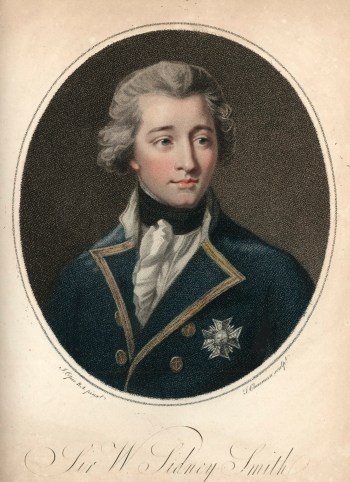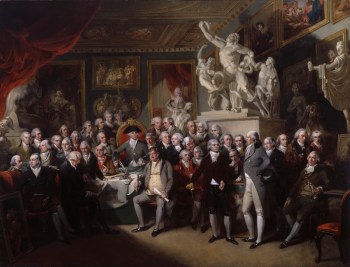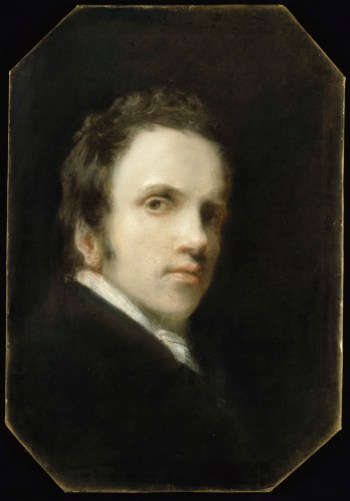John Opie RA (May 1761 - 1807)
RA Collection: People and Organisations
Born in Cornwall, John Opie was a precocious child with a clear talent for drawing and painting. In his early teens, Opie was ‘discovered’ by Dr John Wolcot, an amateur artist and critic, who greatly supported the young Opie and promoted his career.
After some years as an itinerant portrait-painter in Cornwall, Opie moved with Wolcot to London in 1781, where the latter encouraged Opie’s image as a rustic and brilliant artist from the provinces, somewhat uncivilised but curious for London art circles. Opie was inundated with commissions and clients, and even sold two paintings to King George III within a few months of moving to London. Around the same time he was introduced to Sir Joshua Reynolds, who was impressed by his paintings and persona.
In December 1782 Opie married Mary Bunn, a union which led to a distancing with Wolcot for financial reasons. In the following years, Opie showed an aptitude for child portraiture, leading to numerous aristocratic commissions, and also developed a unique style of realistic genre painting, for example Thomas Daniell and Captain Morcom, with Polperro Mine, St. Agnes, in the Background (1786; Truro, County Museum and Art Gallery). During this time he also ventured into history painting, exhibiting The Assassination of James I of Scotland (destroyed) as his first large-scale history painting at the Royal Academy in 1786, to great acclaim.
In the same year, Opie travelled through the Low Countries, studying Dutch and Flemish masterpieces. The Rembrandt paintings he encountered left a lasting impression on him and many elements of his mature painting exhibit Rembrandt-esque qualities.
Opie was elected an associate of the Royal Academy in 1786 and became a full Academician in 1787. His wife Mary left him in 1795 and in 1798 Opie married the writer and activist Amelia Alderson (1769–1853). In their marriage, both partners were able to flourish in their artistic professions, with Opie encouraging Amelia’s work as a novelist and Amelia championing Opie as a painter.
In 1802, the Opies travelled to Paris where they met several notable artists including Benjamin West and Maria Cosway, and Opie where was able to study the huge number of artworks looted by Napoleon from across Europe. The paintings he saw during this trip became an important source for his lectures as Professor of Painting at the Royal Academy (from 1805), which he delivered in 1807. Just a few days after delivering these lectures, Opie fell ill with a fever and died on 9 April 1807.
RA Collections Decolonial Research Project - Extended Biography
Opie’s second marriage was to Amelia Alderson (1769–1853), a novelist, poet and activist. They married in 1798 and, with Opie’s encouragement, Amelia gained great literary success. Amelia was also prominent in her opposition to the slave trade, and the Opies were associated with abolition campaigners such as Mary Wollstonecraft, Elizabeth Fry and Thomas Fowell Buxton.
As an activist, most of Amelia’s campaigning took place after her husband’s death in 1807. She was a founder of the Norwich branch of the Anti-Slavery Society in the 1820s and represented Norwich at the World Anti-Slavery Convention in London in 1840. Amelia also wrote and published anti-slavery poetry and prose.
For more information on this research project, please see https://www.royalacademy.org.uk/article/ra-collections-decolonial-research
Relevant ODNB entries
Simon, Robin. “Opie, John (1761–1807), portrait and history painter.” Oxford Dictionary of National Biography. 23 Sep. 2004; Accessed 1 Mar. 2022. https://www-oxforddnb-com.lonlib.idm.oclc.org/view/10.1093/ref:odnb/9780198614128.001.0001/odnb-9780198614128-e-20800
Kelly, Gary. “Opie [née Alderson], Amelia (1769–1853), novelist and poet.” Oxford Dictionary of National Biography. 23 Sep. 2004; Accessed 1 Mar. 2022. https://www-oxforddnb-com.lonlib.idm.oclc.org/view/10.1093/ref:odnb/9780198614128.001.0001/odnb-9780198614128-e-20799
Profile
Born: May 1761 in St. Agnes, near Truro, Cornwall, England, United Kingdom
Died: 9 April 1807
Nationality: British
Elected ARA: 6 November 1786
Elected RA: 13 February 1787
Professor of Painting: 1805 - 1807
Gender: Male
Preferred media: Painting
Works by John Opie in the RA Collection
2 results
Works after John Opie in the RA Collection
10 results
-
![John Opie RA, Illustration to The Tatler, No. 233]()
After John Opie RA
Illustration to The Tatler, No. 233, 17 February 1804
Line-engraving
-
![Robert Hindry Mason, Portrait of Francesco Bartolozzi RA]()
Robert Hindry Mason
Portrait of Francesco Bartolozzi RA, ca. 1850-60?
Mezzotint
-
![John Opie RA, Self-portrait]()
After John Opie RA
Self-portrait
Stipple engraving
-
![John Opie RA, Portrait of Prince Hoare]()
After John Opie RA
Portrait of Prince Hoare, 1807
Stipple engraving
-
![John Opie RA, Self-portrait]()
After John Opie RA
Self-portrait, 1809
Mezzotint
-
![John Opie RA, Self-portrait]()
After John Opie RA
Self-portrait
Stipple-engraving
-
![John Opie RA, Self-portrait]()
After John Opie RA
Self-portrait
Stipple-engraving
-
![John Opie RA, Self-portrait]()
After John Opie RA
Self-portrait, Published c. 1790-1800?
Crayon manner engraving
-
![John Opie RA, Portrait of Sir William Sidney Smith]()
After John Opie RA
Portrait of Sir William Sidney Smith, 6 May 1796
Stipple engraving
-
![John Opie RA, Self-portrait]()
After John Opie RA
Self-portrait, 2 January 1798
Mezzotint
Works associated with John Opie in the RA Collection
3 results
Associated books
7 results
-
John Opie RA
Lectures On Painting, Delivered At The Royal Academy Of Arts: With A Letter On The Proposal For A Public Memorial Of The Naval Glory Of Great Britain. By The Late John Opie, Esq. Professor In Painting To The Royal Academy. To Which Are Prefixed, A Memoir By Mrs. Opie, And Other Accounts Of Mr. Opie's Talents And Character. - London:: 1809.
05/2049
-
William Shakespeare
The Dramatic Works Of William Shakspeare Revised By George Steevens. Vol. I. (- IX.) - London: -: [1802]
04/3206
-
A Collection Of Prints, From Pictures Painted For The Purpose Of Illustrating The Dramatic Works Of Shakspeare, By The Artists Of Great-Britain. Volume I. (II.) - London,: [1803]
04/3171
-
William Combe
A History Of The University of Cambridge, Its Colleges, Halls, And Public Buildings. In Two Volumes. Vol. I.(II.) - London: 1815.
13/1577
Associated archives
30 results
-
Commonplace Book "F", in diary form
1822-1826
Item WA/6
-
Commonplace book containing conversations with James Northcote
1813-1821
Item WA/5
-
Agreement between Thomas Provis, Ann Mary Provis and J.F. Rigaud, Jos. Farington, John Opie, Robt. Smirke, Thos. Stothard, Rhd. Westall and
13 Jan 1797
Item 634/2
-
![, T. L[awrence], to Joseph Farington, Marlborough Buildings, Bath]()
T. L[awrence], to Joseph Farington, Marlborough Buildings, Bath
[27 Jan 1810]
Item LAW/1/231















![, T. L[awrence], to Joseph Farington, Marlborough Buildings, Bath](https://d1inegp6v2yuxm.cloudfront.net/royal-academy/image/upload/c_limit,cs_tinysrgb,dn_72,dpr_auto,f_auto,fl_progressive.keep_iptc,w_350/jmv8du2ahmocqm4ummke.jpeg)